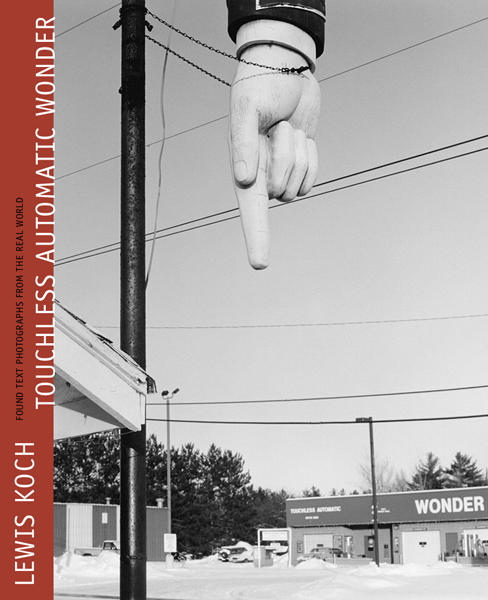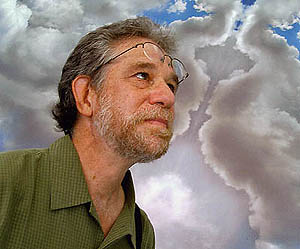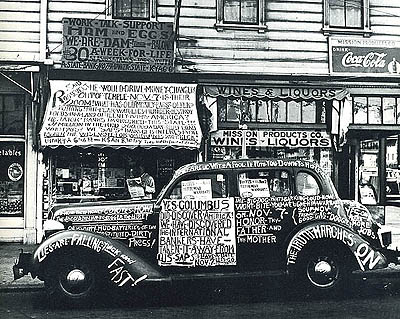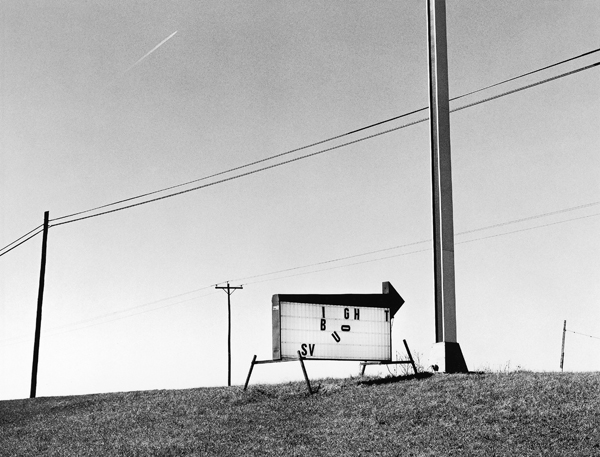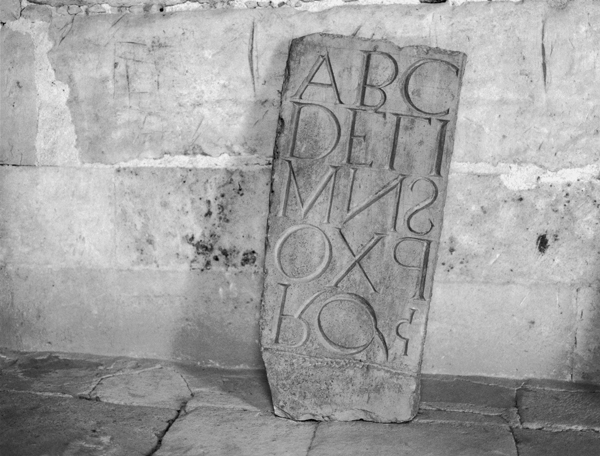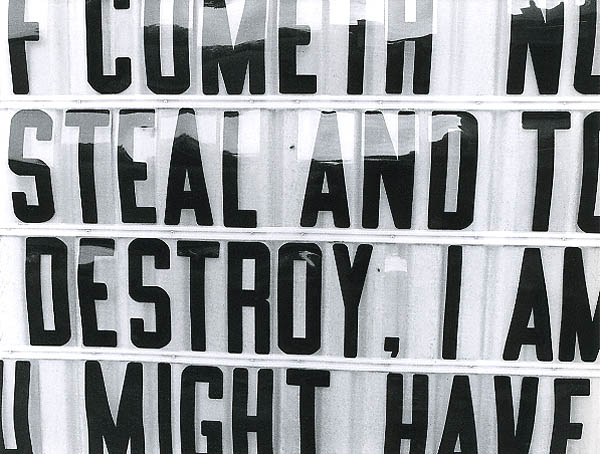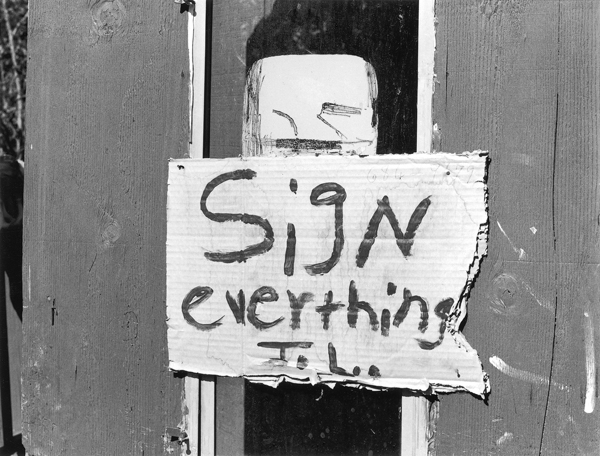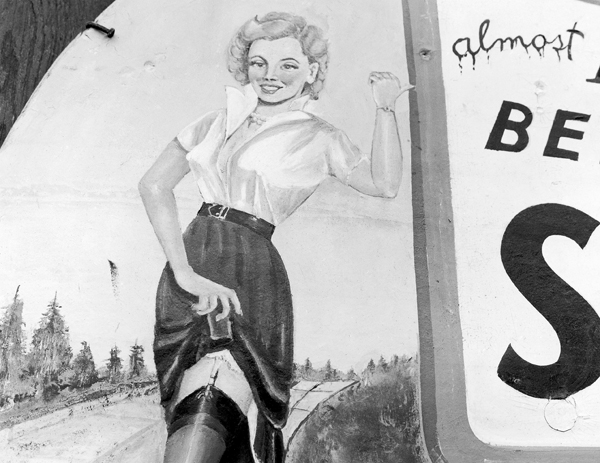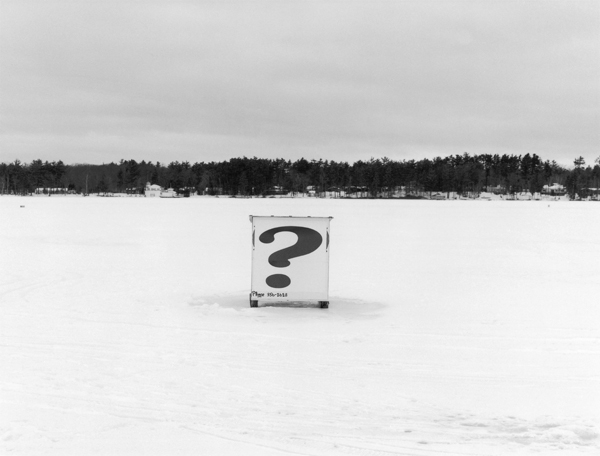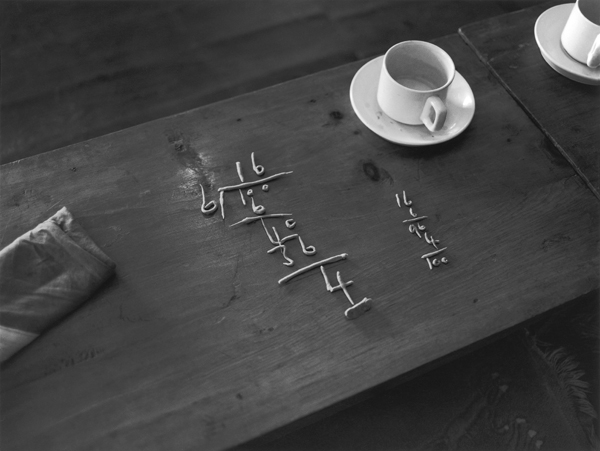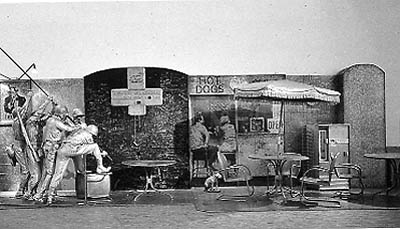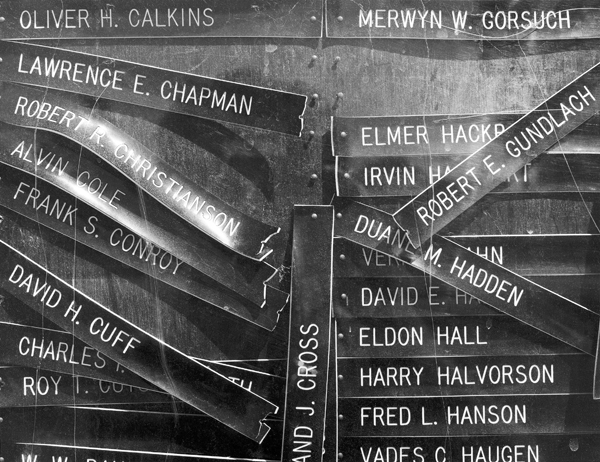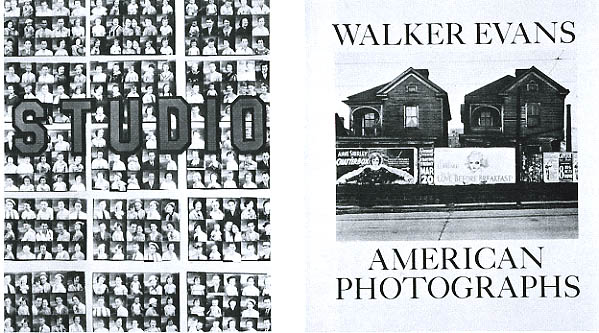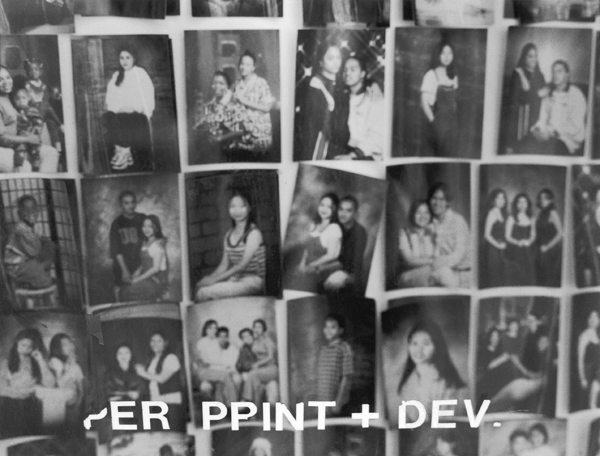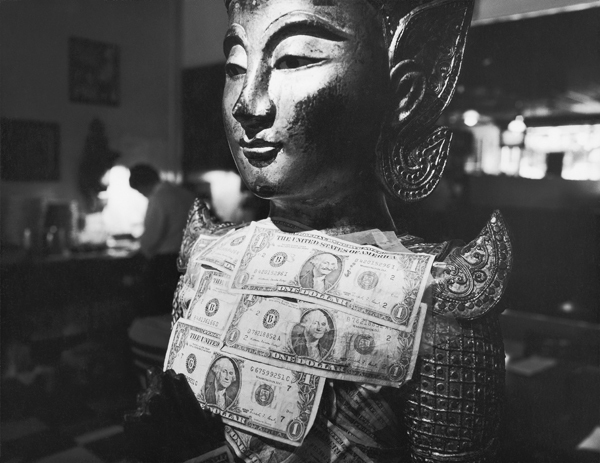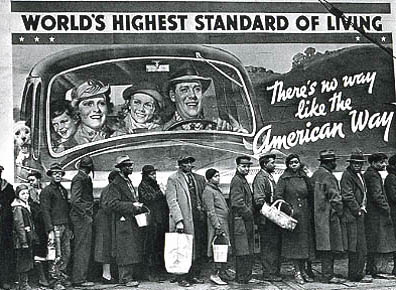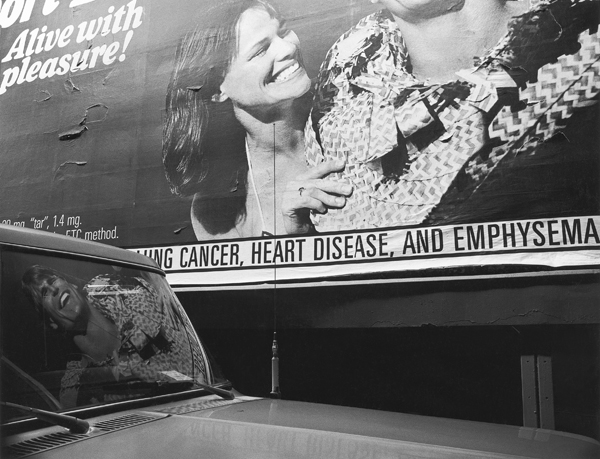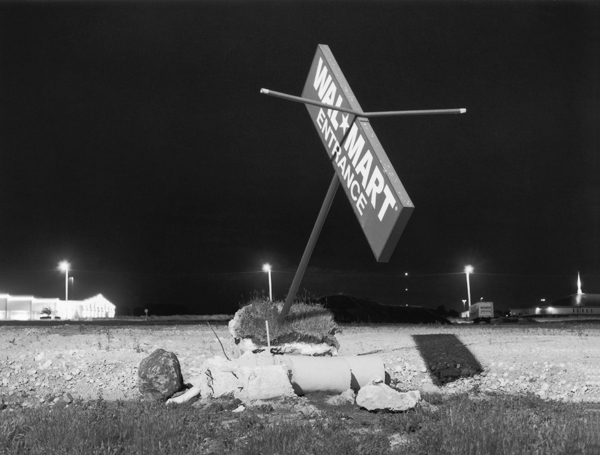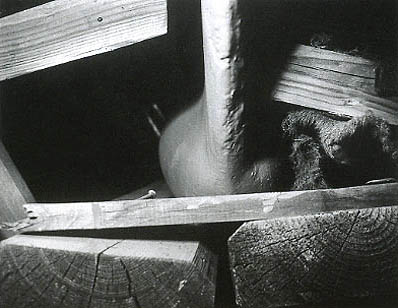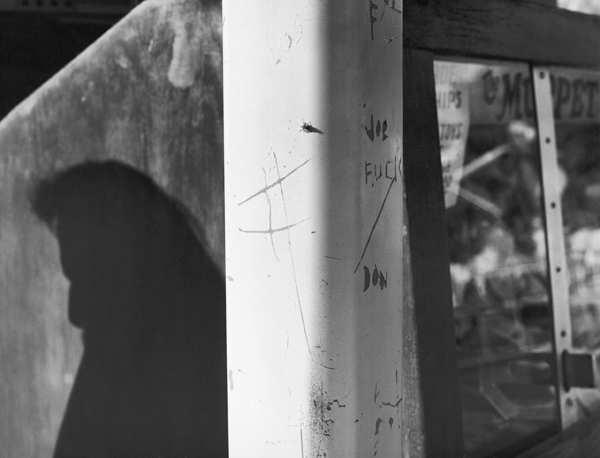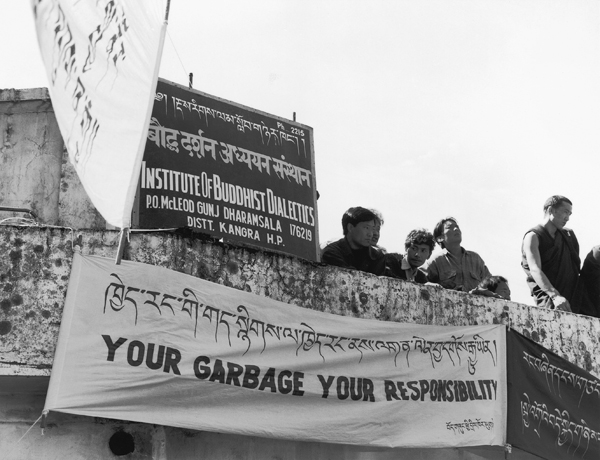Book Review by James R. HuguninTOUCHLESS
AUTOMATIC WONDER, a photographic book by Lewis Koch
|
|
|
For further documentation of projects, and images: Read a short review of this book by another author Garageography
3.0.7, a virtual
tour of a 2006 public art project Touchless
Automatic Wonder, an overview of work prior to 2001 |
|
"I like seeing things and I like words. There is something revelatory about the two together, an almost pentecostal feeling of seeing in tongues," writes Madison, Wisconsin-based photographer, Lewis Koch, in the introduction to his photobook Touchless Automatic Wonder (2009).
Seeing in tongues -- an incisive metaphor for this carefully considered sequence of seventy-nine images redacted from photographs made on four continents over a period of twenty-five years. Right-brain and left-brain rub against each other, sparking enigmatic word-in-image productions, leaving us, well, wondering. Rejecting modernist, purist photography's aversion to the encroachment of language, embracing the late John Gutmann's passion for a language-suffused world, Koch has made the postmodern "linguistic turn," seeing our mass-mediated world today as a complex scripto-visual topology, fragments of which are wittily caught in the net of his camera's frame.
Working with these visual fragments, the "ruins" our postmodern
life-world, Koch constructs a concatenation of truths about our contemporary
damaged world, a visual parallel to Theodor Adorno's insight that the
"fragment is that part of the totality of the work that opposes
totality," such that in our damaged world the "whole is the
untrue" (Minima Moralia: Reflections on a Damaged Life, Adorno).
For instance, in Mount
Horeb, Wisconsin, USA (1981) a four-legged sign seems to
graze like a cow on a rolling Wisconsin slope, its message wholly discombobulated,
a creature babbling its first attempt at words. Formally, the image
is constructed out of various line segments: the arrow-topped sign with
legs, telephone poles, that tall pole whose supposed sign on top is
cropped out of frame, and the added touch of a jetliner's contrail far
above; below, that gentle curve of the horizon contrasts nicely against
all those straight lines. An incisive composition which asserts itself
as a fragment made out of other fragments.
As if to suggest a kind of "Rosetta Stone" in relation to this and other images that follow, this handsomely-printed book's frontispiece depicts a stone tablet, a fragment found in the Catedral Vieja, Salamanca, Spain on which is carved a jumbled, dyslexic version of he Roman alphabet; on the title page opposite one notes the book's subtitle: "Found Text from the Real World."
Further into the book, Preacher's signboard, Tracy City, Tennessee, USA (1994) depicts these letters, now formed into fragmented words -- Come, Steal, Destroy, Might -- a tightly-cropped array of words with a powerful range of possible meanings depending upon context; here context is made ambiguous through cropping. Other times, Koch achieves the same by obscuring the text with people and objects, or through the fact that the text has partially peeled off. The found text is freed from its semantic moorings, letting the textual fragments float connotatively into our minds where we are challenged to make our own sense of it.
What follows in the book are some of the most thought-provoking images (signs) one has seen-read; a carefully arranged collection where the-play-of-the-signifier ("Sign ever[y]thing," reads J. L. Nipper's studio door in one of Koch's photos) has been given maximum latitude by scene chosen, manner of cropping, and the unseen machinations of human agency behind the textual component of the image. In turn, one's latitude of possible responses range from laughter (that "almost Be S" looking like judgmental margin gloss next to the image of the blonde hitchhiker on the sign-painter's ad), to head-scratching puzzlement (the question mark sign on a barren, frozen lake), to utter wonder (a math problem worked out in what looks like fragments of rolled dough).
Many of the images in Koch's book could be generally described by the phrase "things fall apart," so prevalent is the theme of entropy. Small town Vietnam war memorial,Wisconsin, USA (1990) is startling in that a list of names on a war memorial have been permitted to be reduced to state of utter dishevelment. Soldiers' names, the memory of their sacrifice, are given the same kind of indifference they were subjected to by their government in the first place. In a succinct visual statement, Koch is able to say as much or more about war, memory, and death than Edward Kienholz did in his controversial installation, Portable War Memorial (1968).
Koch's production bears comparison with other significant artistic production, especially as not a few of Koch's images pay homage to earlier photographers. Photo studio storefront, San Francisco, California, USA (1998) is an obvious homage with a twist to Photographer's Window Display, Birmingham, Alabama, USA (1936), an image in Walker Evans's classic photobook, American Photographs (1938). Whereas Evans's image presents a perfect grid with the word STUDIO clearly rendered across it, Koch's grid of portraits is found in disarray and the text is fragmentary, peeling off.
Both Evans and Koch level a critical eye at commercial America during times of national distress; both offer a new view of the American vernacular through minute particulars of the world. But Evans composes his subjects quite formally with a view camera, often frontally. Koch's hand camera is wielded in a freer fashion like Robert Frank did in The Americans (1959). Moreover, where Evans's subject was the changing face of American society in his day, Koch's reach is global, indicating the inexorable march of American late-capitalism and popular culture into foreign lands and the suffusion of the foreign into our homeland as seen in Thai restaurant, New York, New York, USA (1990), where such disparate symbols as the Buddha and U.S. currency are shoved up against each other, a visual comment that recalls similar imagery in Frank's photobook, The Americans. Recall such images as Santa Fe, New Mexico (1955-56), where the SAVE sign oversees an anthropomorphic congregation of gasoline pumps (the word is semantically ambiguous and could refer to saving one's soul or saving money at the pump, suggesting a corrupting of religious sentiment); and St. Francis, gas station, and City Hall, Los Angeles (1955-56), which figures that symbol of poverty and piety gesturing his crucifix toward a decadent postwar capitalist society in need of salvation.
The absent-real and the political run through Koch's book; for instance, in Manitowoc, Wisconsin, USA (1999) that much-despised store, Walmart, has seemingly vanished and its entrance sign uprooted like a tree hit by a Midwestern tornado. The sign pitches out toward us from a black night sky, but its shadow retreats backwards and to the side. The actual store is replaced here with an unruly fragment, its abjected signage. Anti-big-box store advocates can rub their hands in glee at this instance of a damaged world.
This dark, damaged world of Koch's Walmart shows up in Chicago photographer Barbara Crane's Monster Series from the early 1980s -- just seen by this writer is her traveling retrospective -- but in a more concentrated form. Another image in Touchless -- Watermelon Days midway, Pardeeville, Wisconsin, USA (1990) -- shows Koch similarly using close-up to render fragments enigmatic, but now textual elements absent from Crane's approach -- a tic-tac-toe grid, the word "fuck," etc. -- are featured.
In summary, Koch takes the "garbage" of our everyday life, the fragments of surviving stuff scattered about, and takes responsibility for it, in a visual sense. He's a bricoleur making intelligent pictorial concatenations of our cultural leftovers, conferring different meanings and possible functions on these fragments and pieces, permitting us the pleasure of joining him in wondering about all that stuff out there.
Koch's conception of the fragment as developed in these photographs puts in question the very idea of a unified totality and leads us toward a new conception of totality as non-unified, fragmented or dismembered, however paradoxical that notion may seem. This new book will be a welcome companion on your bookshelf next to those classics, Evans's American Photographs and Frank's The Americans. -- The End -- |
|
James Hugunin
teaches Photographic History and Critical Theory at
The
School of the Art Institute and is the Managing Editor of U-Turn E-zine |
